2014 MERCEDES-BENZ B-CLASS SPORTS ignition
[x] Cancel search: ignitionPage 18 of 360

SmartKey
Changing the battery .......................76
Changing the programming .............75
Checking the battery .......................76
Convenience closing feature ............84
Convenience opening feature ..........84
Display message ............................ 237
Door central locking/unlocking .......74
Important safety notes ....................74
Loss ................................................. 78
Mechanical key ................................ 75
Positions (ignition lock) .................137
Problem (malfunction) .....................78
Starting the engine ........................138
SmartKey position s(ignition lock) ..137
Sno wchains ...................................... 315
Sockets Center console .............................. 264
Luggage compartment ...................265
Points to observe before use .........264
Rea rcompartmen t......................... 265
Specialist workshop ............................ 25
Speed, controlling see Cruise control
Speedometer
Activating/deactivating the
additiona lspeedometer .................202
Digita l............................................ 195
In the Instrument cluster .................31
Segments ...................................... 191
Selecting the unit of measurement 202
see Instrument cluster
SRS
see SRS (Supplemental Restraint
System)
SRS (Supplemental Restraint
System)
Display message ............................ 216
Introduction ..................................... 40
Warning lamp ................................. 244
Warning lamp (function) ................... 41
Standin glamps
Changing bulbs .............................. 113
Display message ............................ 222
Switching on/off ........................... 106
Start/stop function
see ECO start/stop function
Starting (engine) ................................ 137 Status overview (on-board
computer)
.......................................... 199
STEE RCONTROL .................................. 70
Steering (display message) ..............236
Steering wheel Adjusting (manually )........................ 98
Button overview ............................... 33
Buttons (on-board computer) ......... 191
Cleaning ......................................... 290
Important safety notes ....................98
Paddle shifters ............................... 147
Steering wheel paddle shifters ........147
Stowage areas ................................... 251
Stowage compartments Armrest (front) ............................... 252
Armrest (under) ............................. 252
Center console .............................. 251
Cuph olders ................................... 261
Eyeglasses compartment ...............251
Glove box ...................................... .251
Important safety information .........251
Parce lnet ...................................... 253
Under driver's seat/front-
passenger sea t.............................. 252
Stowage space
Center console (rear) .....................252
Summer tires ..................................... 314
Sun visor ............................................ 263
Surround lighting (on-board
computer) .......................................... 204
Switchin gair-recirculation mode
on/off ................................................. 132
Switchin goff the alarm (ATA) ............70 T
Tachometer ........................................ 191
Tailgate Display message ............................ 235
Emergency unlocking .......................82
Important safety notes ....................81
Opening/closing (from outside) .......82
Opening dimensions ......................353
Tail lamps
Display message ............................ 221
see Lights
Tank content
Fuel gauge ....................................... 3116
Index
Page 26 of 360
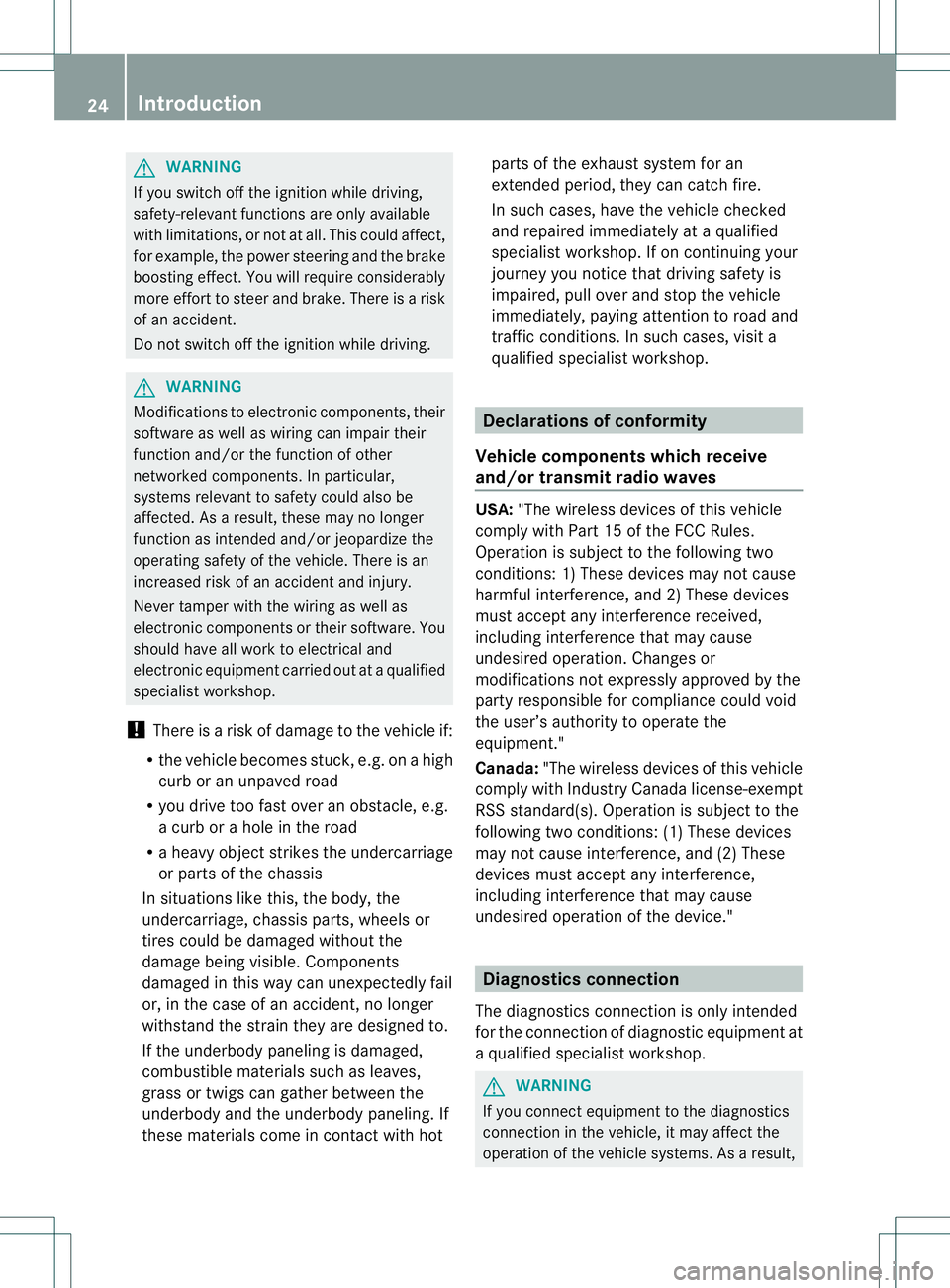
G
WARNING
If you switch off the ignitio nwhile driving,
safety-relevant functions are only available
with limitations, or not at all. This could affect,
for example, the power steering and the brake
boosting effect.Y ou will require considerably
more effort to steer and brake. There is arisk
of an accident.
Do not switch off the ignition while driving. G
WARNING
Modifications to electronic components, their
software as well as wiring can impair their
function and/or the function of other
networked components. In particular,
systems relevant to safety could also be
affected. As aresult, these may no longer
function as intended and/or jeopardize the
operating safety of the vehicle. There is an
increased risk of an accident and injury.
Never tamper with the wiring as well as
electronic components or their software. You
should have all work to electrical and
electronic equipment carried out at aqualified
specialist workshop.
! There is arisk of damage to the vehicle if:
R the vehicle becomes stuck,e .g. onahigh
cur boranu npavedroad
R yo ud rive too fas tover an obstacle, e.g.
ac urb or ahole in the road
R ah eavy object strikes the undercarriage
or parts of the chassis
In situations like this, the body ,the
undercarriage, chassi sparts, wheels or
tires coul dbedamaged without the
damage being visible .Components
damaged in this way can unexpectedly fail
or, in the case of an accident ,nolonger
withstand the strain they are designed to.
If the underbody paneling is damaged,
combustible materials such as leaves,
grass or twigs can gather between the
underbody and the underbody paneling. If
these materials come in contact with hot parts of the exhaust system for an
extended period, they can catchf
ire.
In such cases, have the vehicle checked
and repaired immediately at aqualified
specialist workshop. If on continuing your
journey you notice that driving safety is
impaired, pull over and stop the vehicle
immediately, paying attention to road and
traffic conditions. In such cases, visit a
qualified specialist workshop. Declarations of conformity
Vehicle components which receive
and/or transmit radio waves USA:
"The wireless devices of this vehicle
comply with Part 15 of the FCC Rules.
Operation is subject to the following two
conditions: 1) These devices may not cause
harmful interference, and 2) These devices
must accept any interferenc ereceived,
including interferenc ethat may cause
undesired operation. Changes or
modifications not expressly approved by the
party responsible for compliance could void
the user’s authority to operate the
equipment."
Canada: "The wireless devices of this vehicle
comply with Industr yCanada license-exempt
RSS standard(s). Operation is subject to the
following two conditions: (1) These devices
may not cause interference, and (2) These
devices must accept any interference,
including interferenc ethat may cause
undesired operation of the device." Diagnostics connection
The diagnostics connection is only intended
for the connection of diagnostic equipment at
aq ualified specialist workshop. G
WARNING
If you connect equipment to the diagnostics
connection in the vehicle, it may affect the
operation of the vehicle systems. As aresult, 24
Introduction
Page 32 of 360
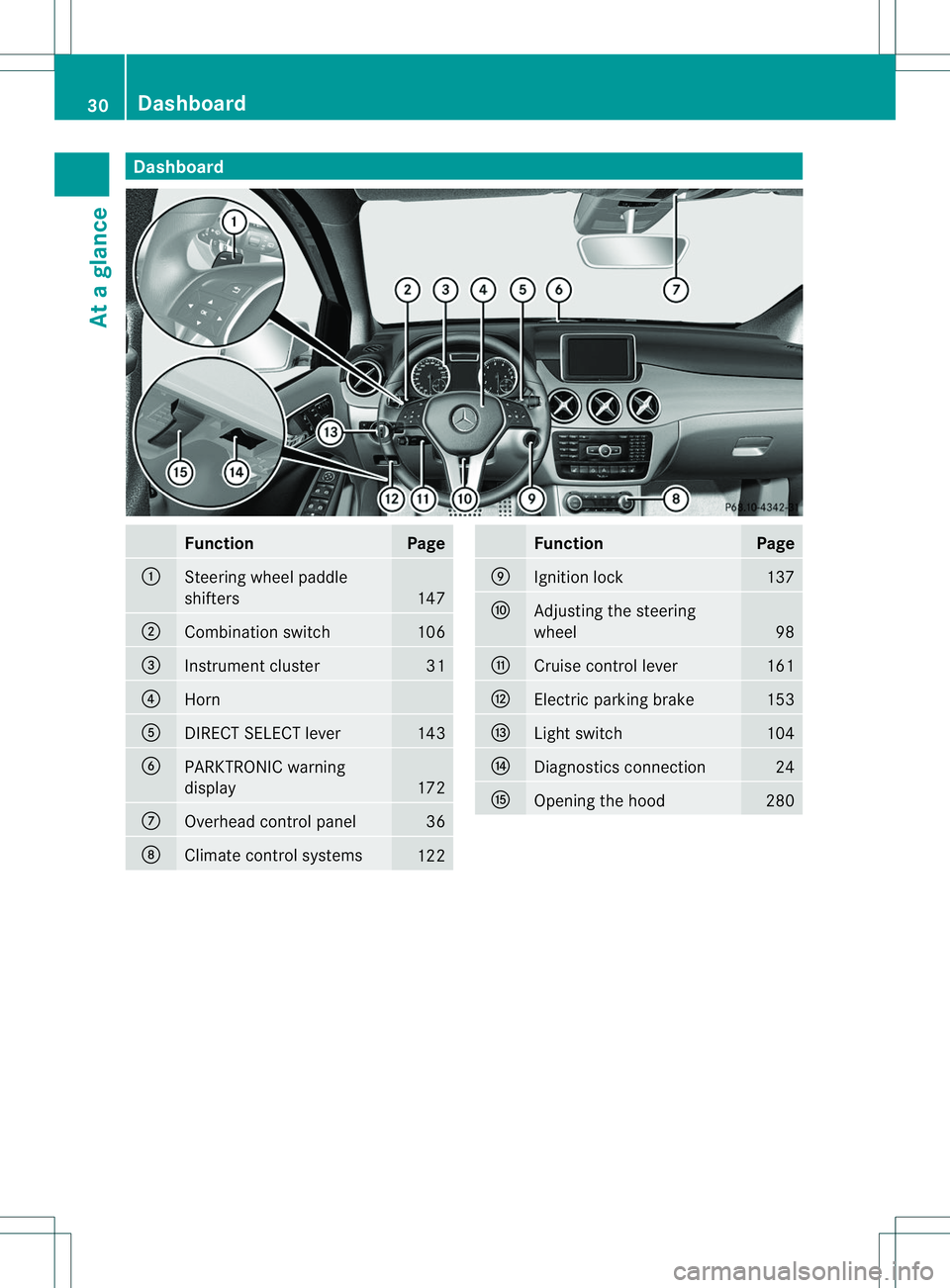
Dashboard
Function Page
001A
Steerin
gwhee lpaddle
shifters 147
0010
Combination switch 106
0023
Instrumen
tcluster 31
0021
Horn
001E
DIREC
TSELEC Tlever 143
0024
PARKTRONIC warning
display
172
0007
Overhead contro
lpanel 36
0008
Climat
econtrol systems 122 Function Page
0009
Ignition lock 137
0016
Adjustin
gthe steering
wheel 98
001D
Cruis
econtrol lever 161
0004
Electric parking brake 153
000B
Light switch 104
001C
Diagnostic
sconnection 24
000E
Opening th
ehood 28030
Dashboa
rdAtag lance
Page 42 of 360

Useful information
i This Operator's Manual describes all
models and all standard and optional
equipment of your vehicle available at the
time of publication of the Operator's
Manual. Country-specific differences are
possible. Please not ethat your vehicle may
not be equipped with all features
described. This also applies to safety-
related system sand functions.
i Read the information on qualified
specialist workshops: (Y page 25).Panic alarm
X
To activate: press0004button 001Afor at
least one second.
An alarm sounds and the exterior lighting
flashes.
X To deactivate: press0004button 001A
again.
or
X Insert the SmartKey int othe ignition lock. Occupant safety
Important safet
ynotes G
WARNING
Modifications to the restraint system scould
result in them not functioning properly any
more. The restraint system scould then no longer protect vehicle occupants as they are
designed to do and could fail in the even
tof
an acciden toractivat eunexpectedly, for
example. Ther eisanincreased risk of injury.
Never modify part softherestraint systems.
Do no tattemp ttomodify the wiring as well as
electronic components or their software.
If it is necessary to modify an air bag system
to accommodat eaperson with disabilities,
contact an authorized Mercedes-Benz center.
USA only: for further information contact our
Customer Assistance Center at
1-800-FOR-MERCedes (1800-367-6372).
In this section ,you will learn the most
important facts about the restraint system
components of the vehicle.
The restraint system consist sof:
R Seat belts
R Child restraint systems
R LATCH-type (ISOFIX) child seat securing
system
Additional protection is provided by:
R SRS (Supplemental Restraint System)
R Air bag system components with:
-PASSENGER AIR BAG OFF indicator lamp
- Front-passenger seat with Occupant
Classification System (OCS)
Although the systems are independent ,their
protective functions work in conjunction with
each other. Not all air bags are always
deployed in an accident.
i For information on infant sand children
traveling with you in the vehicle restraint
systems for infant sand children, see
"Children in the vehicle" (Y page 56). SRS (Supplemental Restraint System)
Introduction Supplemental Restraint System (SRS) with:
R
The 0021 SRS warning lamp
R Air bags 40
Occupant safetySafety
Page 43 of 360
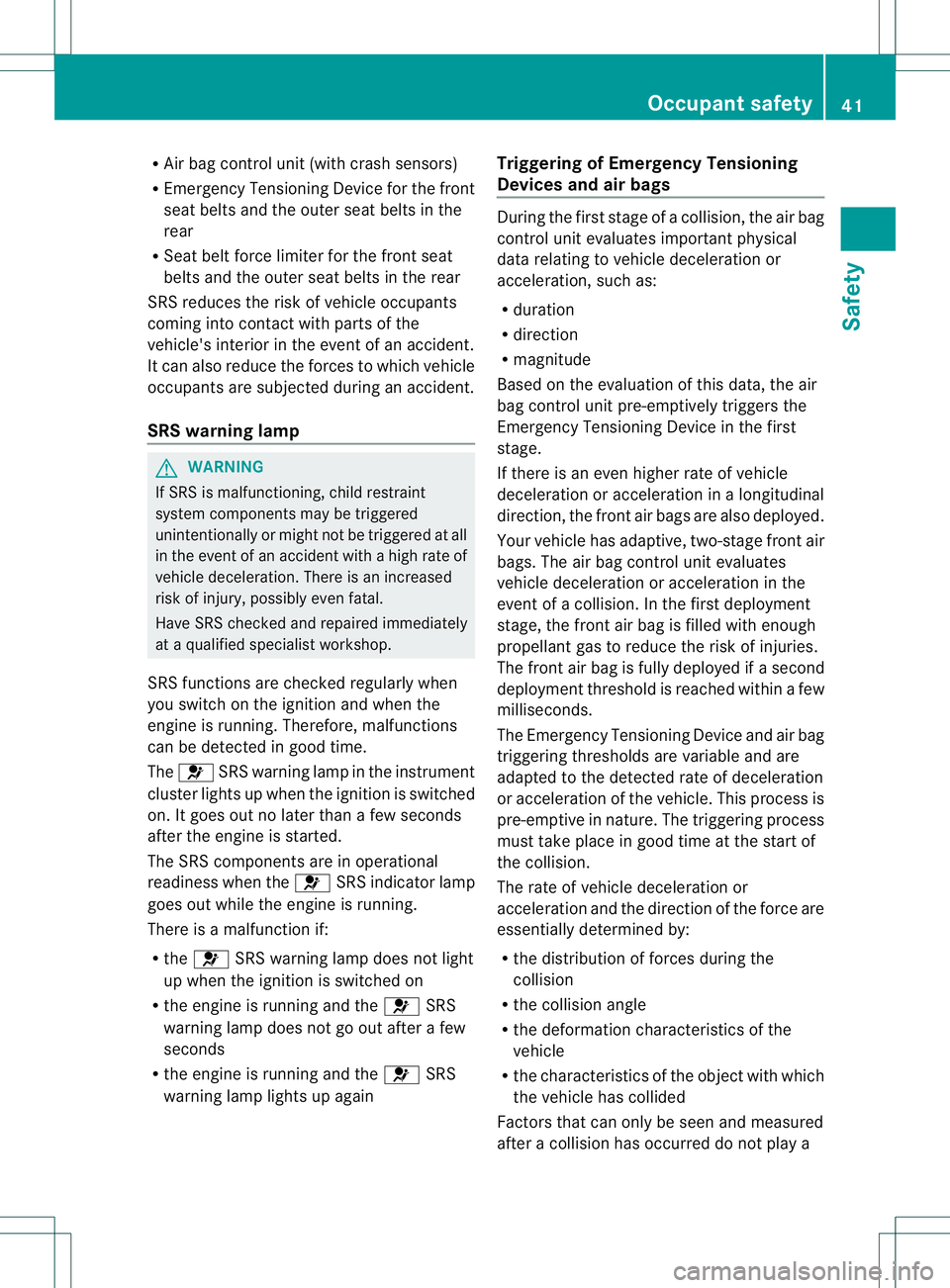
R
Air ba gcontro lunit( with crash sensors)
R Emergenc yTensioning Device for th efront
seat belt sand th eoute rseat belts in the
rear
R Seat belt forc elimiter for the fron tseat
belts and the outer seat belts in the rear
SRS reduces the risk of vehicle occupants
comin gintoc ontact with parts of the
vehicle's interior in the event of an accident.
It can also reduce the forces to which vehicle
occupants are subjected during an accident.
SRS warning lamp G
WARNING
If SRS is malfunctioning, child restraint
system component smay be triggered
unintentionally or might not be triggered at all
in the event of an acciden twith ahigh rate of
vehicle deceleration. There is an increased
risk of injury, possibly even fatal.
Have SRS checked and repaire dimmediately
at aq ualified specialist workshop.
SRS function sare checked regularly when
you switc honthe ignition and when the
engin eisrunning. Therefore, malfunctions
can be detected in good time.
The 0021 SRS warnin glamp in the instrument
cluster light supwhen the ignition is switched
on. It goes out no later than afew seconds
after the engin eisstarted.
The SRS component sare in operational
readiness when the 0021SRS indicator lamp
goes out while the engin eisrunning.
There is amalfunction if:
R the 0021 SRS warnin glamp does not light
up when the ignition is switched on
R the engin eisrunning and the 0021SRS
warnin glamp does not go out after afew
seconds
R the engin eisrunning and the 0021SRS
warnin glamp light supagain Triggering of Emergency Tensioning
Devices and air bags Durin
gthe firs tstag eofac ollision, the ai rbag
control unit evaluates important physical
dat arelating to vehicle deceleratio nor
acceleration, suc has:
R duration
R direction
R magnitude
Based on th eevaluation of this data, th eair
bag control unit pre-emptivel ytrigger sthe
Emergency Tensioning Devic einthefirst
stage.
If there is an eve nhigher rat eofvehicle
deceleratio noracceleration in alon gitudinal
direction, the front ai rbags are also deployed.
Your vehicle has adaptive, two-stag efront air
bags. The air bag control unit evaluates
vehicle deceleration or acceleration in the
even tofa collision. In the firs tdeployment
stage, the fron tair bag is filled with enough
propellan tgas to reduc ethe ri sk of injuries.
The front air bag is fully deployed if asecond
deploymen tthreshold is reached within afew
milliseconds.
The Emergency Tensioning Device and air bag
triggering thresholds are variable and are
adapted to the detected rate of deceleration
or acceleration of the vehicle. This process is
pre-emptive in nature. The triggering process
must take place in good time at the start of
the collision.
The rate of vehicle deceleration or
acceleration and the direction of the force are
essentially determined by:
R the distribution of forces during the
collision
R the collision angle
R the deformation characteristics of the
vehicle
R the characteristics of the object with which
the vehicle has collided
Factors that can only be seen and measured
after acollision has occurred do not play a Occupant safety
41Safety Z
Page 51 of 360
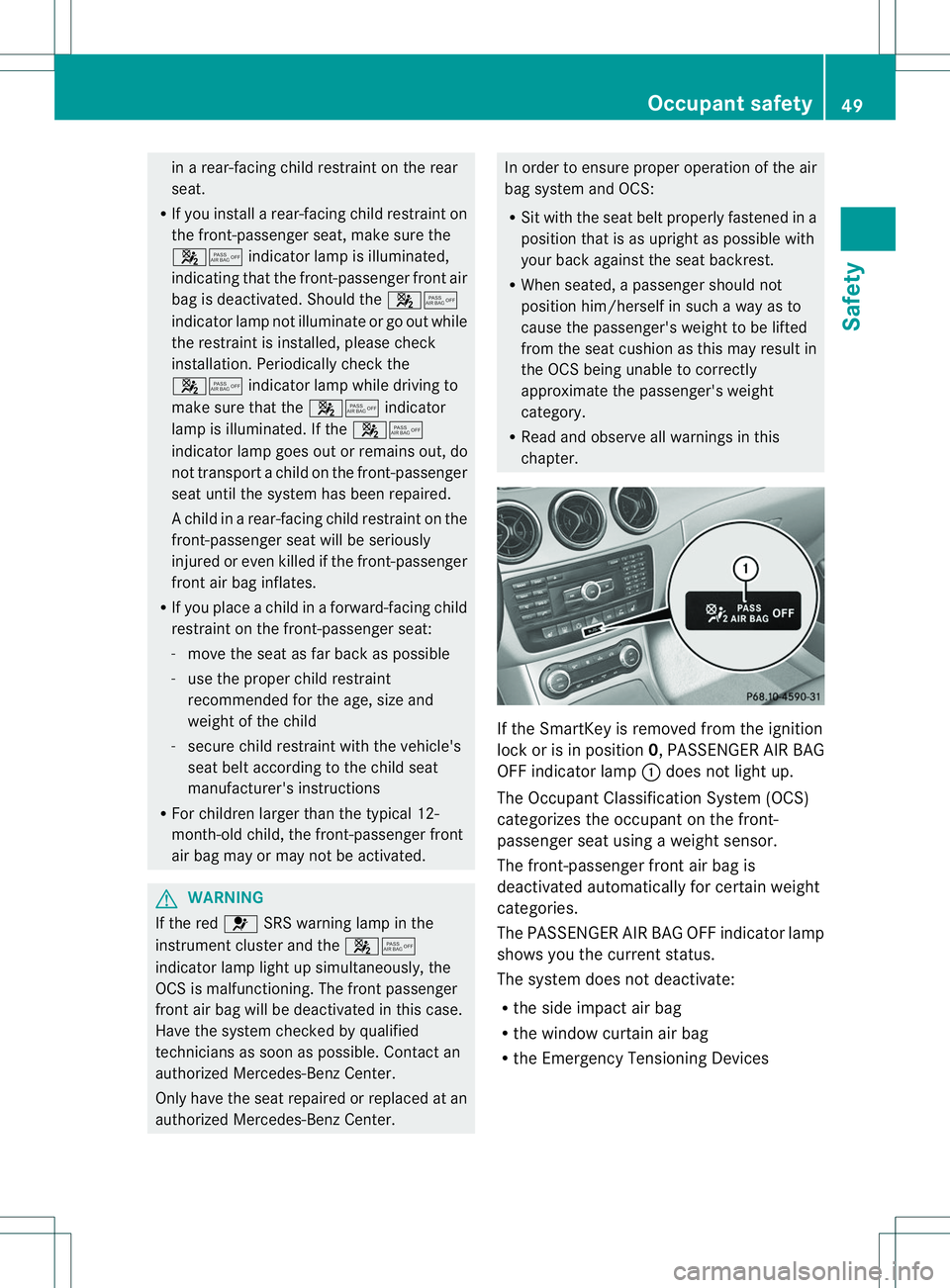
in
ar ear-facin gchild restraint on the rear
seat.
R If you install arear-facin gchild restraint on
the front-passenge rseat, make sure the
000E0013 indicator lamp is illuminated,
indicating that the front-passenger fron tair
bag is deactivated. Should the 000E0013
indicator lamp not illuminat eorgoout while
the restraint is installed, please check
installation .Periodically check the
000E0013 indicator lamp while driving to
make sure that the 000E0013indicator
lamp is illuminated. If the 000E0013
indicator lamp goes out or remains out, do
not transport achild on the front-passenger
seat until the system has been repaired.
Ac hild in arear-facing child restraint on the
front-passenger seat will be seriously
injured or even killed if the front-passenger
front air bag inflates.
R If you place achild in aforward-facing child
restraint on the front-passenger seat:
- move the seat as far back as possible
- use the proper child restraint
recommended for the age, size and
weight of the child
- secure child restraint with the vehicle's
seat belt according to the child seat
manufacturer's instructions
R For children larger than the typical 12-
month-old child, the front-passenger front
air bag may or may not be activated. G
WARNING
If the red 0021SRS warning lamp in the
instrument cluster and the 000E0013
indicator lamp light up simultaneously ,the
OCS is malfunctioning. The front passenger
front air bag will be deactivated in this case.
Have the system checked by qualified
technicians as soon as possible. Contact an
authorized Mercedes-Ben zCenter.
Only have the seat repaired or replaced at an
authorized Mercedes-Benz Center. In order to ensure proper operation of the air
bag system and OCS:
R
Sit with the seat belt properly fastened in a
position that is as upright as possible with
your back against the seat backrest.
R When seated, apassenger should not
position him/herself in such away as to
cause the passenger' sweight to be lifted
from the seat cushion as this may result in
the OCS being unable to correctly
approximat ethe passenger' sweight
category.
R Read and observe all warnings in this
chapter. If the SmartKey is removed from the ignition
lock or is in position 0,PASSENGER AIR BAG
OFF indicator lamp 001Adoes not light up.
The Occupant Classification System (OCS)
categorize sthe occupant on the front-
passenge rseat using aweight sensor.
The front-passenger fron tair bag is
deactivated automatically for certain weight
categories.
The PASSENGER AI RBAG OFF indicator lamp
shows yo uthe current status.
The system does not deactivate:
R the side impact ai rbag
R thew indow curtain air bag
R theE me rgency Tensioning Devices Occupant safety
49Safety Z
Page 52 of 360

To be classified correctly, the frontp
assenger
must sit:
R wit hthe seat belt fastened correctly
R in ap ositio nthat is as upright as possible
with their back against the seat backrest
R with their feet on the floor
The OCS weight sensor reading is affected if
the occupant's weight is transferred, e.g. by
leaning on the armrest.
If the front-passenger seat, the seat cover or
the seat cushion are damaged, have the
necessary repair work carried out at a
qualified specialist workshop.
For safety reasons, Mercedes-Benz
recommends that you only use seat
accessories that have been approved by
Mercedes-Benz.
Both the driver and the front passenger
should always observe the PASSENGER AIR
BAG OFF indicator lamp as an indication of
whether or not the front passenger is
positioned correctly. Observe also the air bag
displaym essages that can be displayed in the
instrumentc luster (Ypage 219).
If the driver's air bag deploys, this does not
mean that the front-passenger front air bag
will also deploy.
The OCS may have detected that the seat:
R is empty or occupied by the weight of a
typical child up to twelve months old,
seated in achild restraint system.
R is occupied by asmall individual, such as a
young teenager or asmall adult.
R is occupied by achild in achild restraint
system whose weight is greater than that
of at ypical twelve montho ld child.
These are examples of when the OCS
deactivates the front-passenger front air bag.
Deactivation takes place although the
collision fulfills the criteria for deploying the
driver's air bag.
For further information ,see "Air bag display
messages" (Y page 219). System self-test G
WARNING
If the 000E0013indicator lamp does not
illuminate, the system is not functioning. You
must contac tanauthorized Mercedes-Benz
Center befor eseatin gany child on the front
passenger seat. G
WARNING
Never place anything betwee nseat cushion
and child seat (e.g. apillow), since it reduces
the effectiveness of the OCS. The underside
and rear side child restraint system must be
placed entirely on the seat cushion and the
backrest of the front-passenger seat
backrest.
If necessary, adjust the tilt of the passenger
seat backrest.
An incorrectly mounted child seat could cause
injuries to the child in case of an accident,
instead of increasing protection for the child.
Follow the manufacturer's instructions for
installation of child restraint systems.
The PASSENGER AIR BAG OFF indicator lamp
lights up:
R if you turn the SmartKey in the ignition lock
to position 1or 2
R if an adult is seated properly on the front-
passenger seat and the OCS classifies the
occupant as an adult
The PASSENGER AIR BAG OFF indicator
lamp goes out again after approximately six
seconds.
If the seat is not occupied and the OCS
detects that the front-passenger seat is
empty, the PASSENGER AIR BAG OFF
indicator lamp will continue to light up. The
PASSENGER AIR BAG OFF indicator lamp
will not go out.
For further information ,see "Problems with
the Occupant Classification System"
(Y page 51). 50
Occupant safetySafety
Page 58 of 360
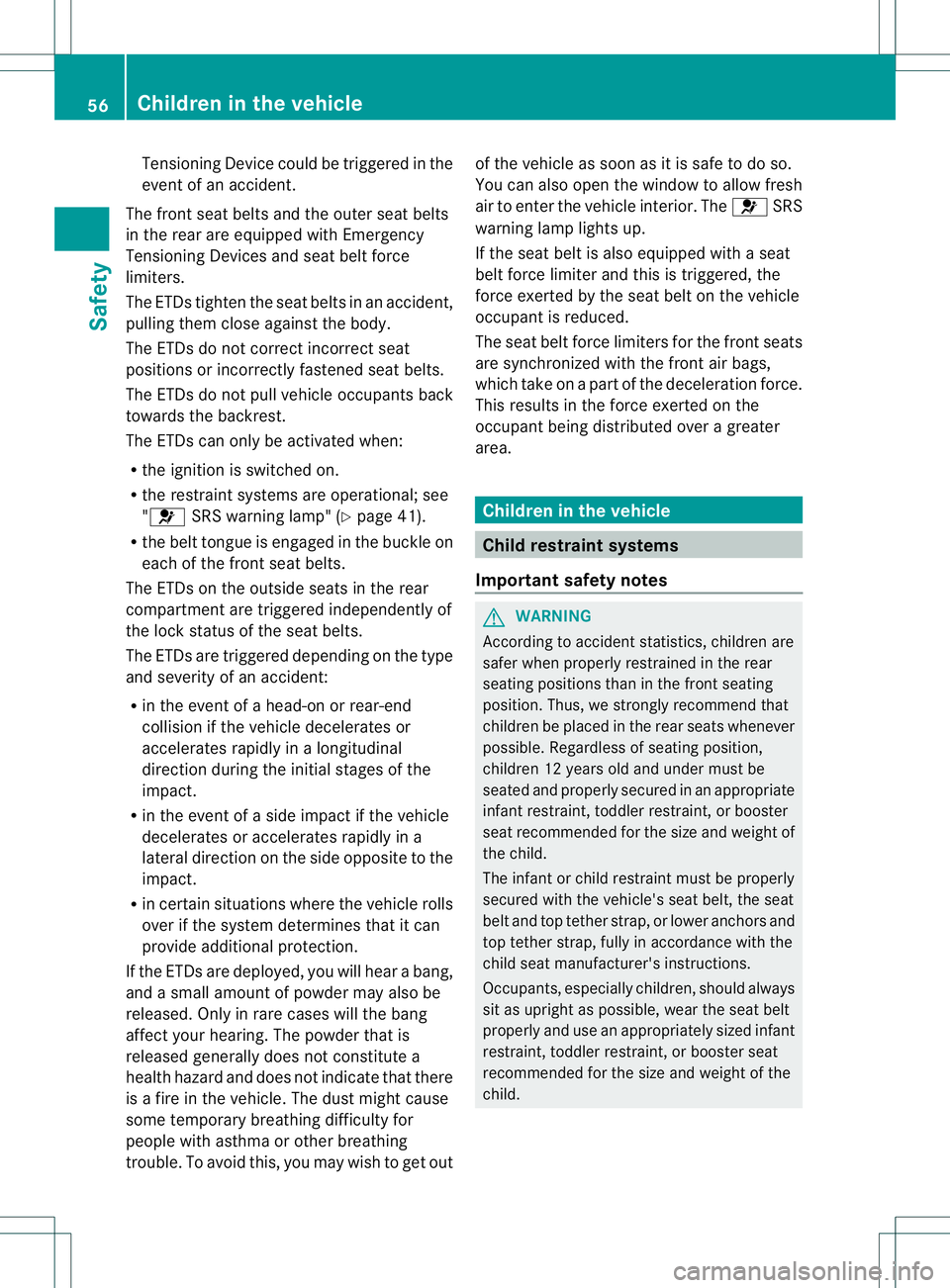
Tensionin
gDevice could be triggered in the
event of an accident.
The fronts eat belts and the outer seat belts
in the rear are equipped with Emergency
Tensioning Devices and seat belt force
limiters.
The ETDst ighten the seat belts in an accident,
pulling them close against the body.
The ETDsdon ot correct incorrect seat
position sorincorrectly fastened seat belts.
The ETDsdon ot pull vehicle occupants back
towards the backrest.
The ETDsc an only be activated when:
R the ignition is switched on.
R the restraint systems are operational; see
"0021 SRS warning lamp" (Y page 41).
R the belt tongue is engaged in the buckle on
each of the fron tseat belts.
The ETDsont he outside seats in the rear
compartment are triggered independently of
the lock status of the seat belts.
The ETDsa re triggered depending on the type
and severit yofanaccident:
R in the event of ahead-on or rear-end
collision if the vehicle decelerates or
accelerates rapidly in alongitudinal
direction during the initial stages of the
impact.
R in the event of aside impact if the vehicle
decelerates or accelerates rapidly in a
lateral direction on the side opposite to the
impact.
R in certain situation swhere the vehicle rolls
over if the system determines that it can
provide additional protection.
If the ETDsa re deployed, you will hear abang,
and asmall amount of powder may also be
released. Only in rare cases will the bang
affect your hearing. The powder that is
released generally does not constitute a
health hazard and does not indicat ethat there
is af ire in the vehicle. The dust might cause
some temporary breathin gdifficult yfor
people with asthma or other breathing
trouble. To avoid this, you may wish to get out of the vehicle as soon as it is safe to do so.
You can also open the window to allow fresh
air to enter the vehicle interior. The
0021SRS
warning lamp lights up.
If the seat belt is also equipped with aseat
belt forc elimiter and this is triggered, the
forc eexerted by the seat belt on the vehicle
occupant is reduced.
The seat belt force limiters for the front seats
are synchronized with the front air bags,
which take on apart of the deceleration force.
This results in the force exerted on the
occupant being distributed over agreater
area. Children in the vehicle
Child restraint systems
Important safety notes G
WARNING
According to accident statistics, children are
safer when properly restrained in the rear
seating positions than in the front seating
position. Thus, we strongly recommend that
children be placed in the rear seats whenever
possible.R egardless of seating position,
children 12 years old and under must be
seated and properly secured in an appropriate
infant restraint, toddler restraint, or booster
seat recommended for the size and weight of
the child.
The infant or child restraint must be properly
secured with the vehicle's seat belt, the seat
belt and top tether strap, or lower anchor sand
top tether strap, fully in accordance with the
child seat manufacturer's instructions.
Occupants, especially children ,should always
sit as upright as possible, wear the seat belt
properly and use an appropriately sized infant
restraint, toddler restraint, or booster seat
recommended for the size and weight of the
child. 56
Children in thev
ehicleSafety